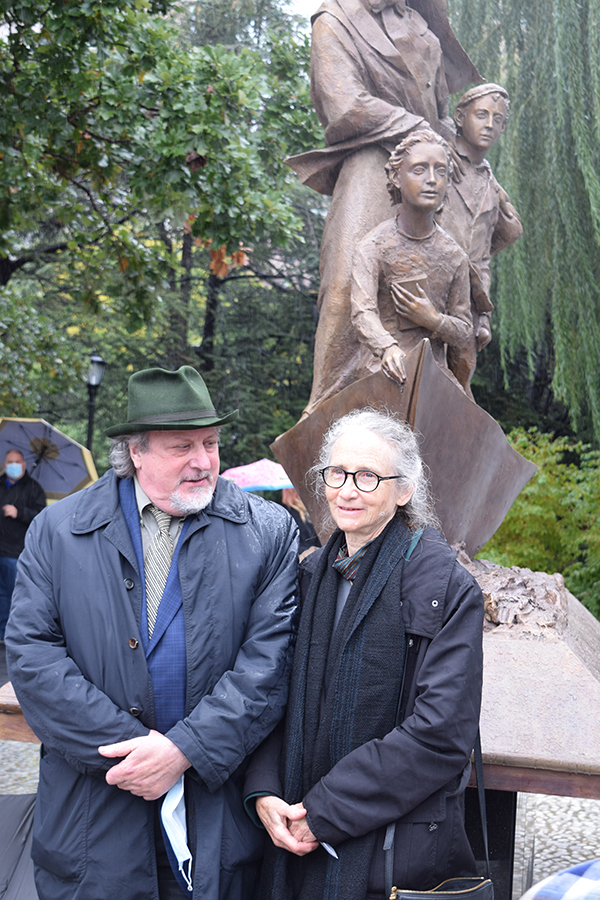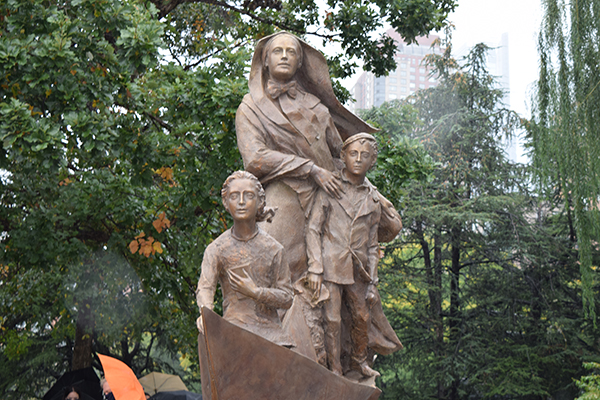
WINDSOR TERRACE — The story behind the Mother Cabrini statue unveiled by Gov. Andrew Cuomo in a ceremony in Battery Park on Oct. 12 is one of perseverance and artistic vision.
The sculptors, Giancarlo Biagi and his adopted daughter Jill Burkee-Biagi, gave The Tablet an inside view of their process from concept to completion.
The bronze statue, depicting a young Mother Cabrini in a small boat with two children, stands in a cove in Battery Park across New York Harbor from the Statue of Liberty and Ellis Island. Mother Cabrini (1850-1917), who hailed from Sant’Angelo Lodigiano, Italy, and came to the U.S. in 1889. She was canonized by Pope Pius XII in 1946 and four years later she was named the Patron Saint of Immigrants.
The statue was completed in a remarkably short time — nine months — which Jill Burkee-Biagi said was because she and Giancarlo have been working together as an artistic team for decades and have created a shorthand in their work process.
The Biagis were selected on Feb. 26 by the Mother Cabrini Memorial Commission from among several artists who submitted designs. They had to overcome several obstacles during the creative process, but they were determined to get the job done.
They initially planned to work on the project in Italy, but COVID-19 lockdowns in that country prevented them from traveling there. They needed to be near a foundry to have the bronze sculpture cast. They planned to work in New York but again, COVID-19 interfered with their plans because of another lockdown. The artists finally wound up driving to Loveland, Colorado, where they worked in a friend’s studio.
“We quarantined ourselves, Jill and I, in order to do this work,” Giancarlo told The Tablet.
The Biagis never flinched, despite the constant reshuffling. They took their inspiration from Mother Cabrini. “She had so much determination; she overcame the odds,” Jill told The Tablet.
From the start, the Biagis’ goal was to pay tribute to Mother Cabrini by incorporating facets of her life in Italy into the design. They also wanted the artwork to have universality in its appeal to the viewer.
“We are all immigrants in one way or another. We all share the immigrant experience,” Giancarlo said.

The boat depicted in the statue is meant to represent a paper boat. As a child, Mother Cabrini enjoyed visiting her uncle, who lived near Venera River. She made boats out of paper and filled them with violets, her favorite flower, before casting the flower-filled boats into the river and watching as the currents carried them away. She wanted the boats to serve as her missionaries to the world, Giancarlo said.
Mother Cabrini’s devotion to education also figured into the design — the girl in the boat is carrying a book. Mother Cabrini founded the Missionary Sisters of the Sacred Heart of Jesus and founded 67 schools, hospitals, and orphanages in the U.S.
“Educating the immigrant, the marginalized, the needy was vital to her,” Giancarlo said.
The boy is carrying a musical instrument known as an ocarina, representing the music and culture that immigrants bring with them from their native lands when they come to America.
The artists also gave careful thought to the statue’s immediate surroundings.
Special Stones
The artwork, which has a granite pedestal, stands on a bed of stones. But they are not just any stones.
“Those are river bed stones,” Giancarlo said, which come from a river near Mother Cabrini’s home in Italy. The stones were obtained with the help of Mother Maria Barbagallo, who is in charge of a museum dedicated to Mother Cabrini in her hometown.
The sculpture was built using a centuries-old process known as lost-wax casting. It involves creating a duplicate metal sculpture (in this case bronze) from an original sculpture.
The Biagis said they were honored to have been selected by the commission, co-chaired by Bishop Nicholas DiMarzio and Angelo Vivolo, president of the Columbus Citizens Foundation, to create the Mother Cabrini statue.
Works by the Biagis, separately and individually, can be found in art galleries and museums worldwide.
Giancarlo, who is originally from Italy, studied at the Istituto d’Arte Stagio Stagi of Pietrasanta. He moved to the U.S. to study at the Art Students League of New York. Jill, a native-born American, studied at the University of Washington and received a fellowship to work and study art in Pietrasanta, Italy, with stone carving artisans.
Today, the Biagis maintain studios in New York and Pietrasanta.
